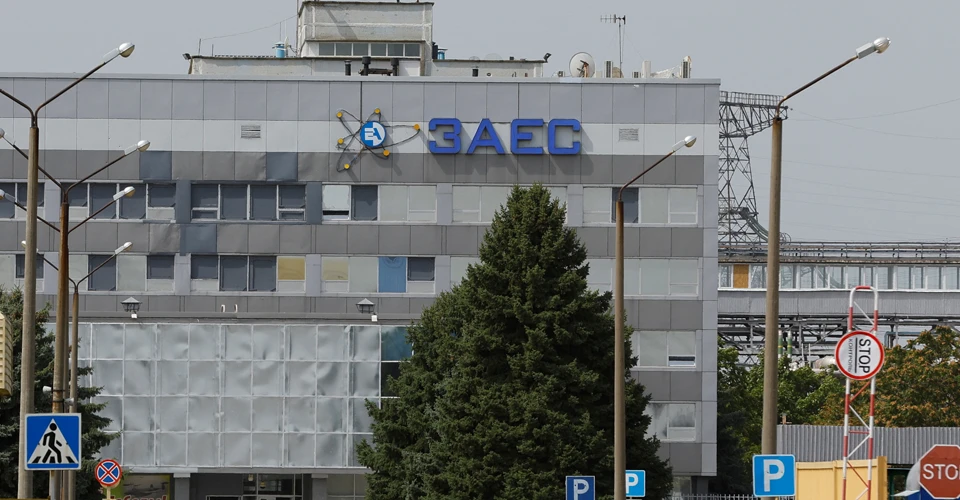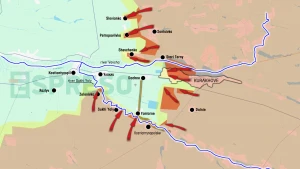
ZNPP loses power from main high-voltage line, station is on verge of another blackout
On the night of July 10, the occupied Zaporizhzhia nuclear power plant lost power from the main high-voltage line of 750 kV. It was switched to the only available backup line of 330 kV
This is reported by Energoatom.
“On the night of August 10, the Zaporizhzhia nuclear power plant, which is currently under occupation, lost its electricity from the main external power line that carries a strong electrical current. This caused a problem because the power plant had to switch to a smaller backup power line. If this backup line is disconnected, there's a risk that the power plant might lose its external power, leading to a complete blackout,” the message says.
The biggest danger in this situation is the fourth power unit being in "hot shutdown" state. Russians are operating it illegally, not following the rules set by the Ukrainian government agency responsible for nuclear safety.
If the external power is completely lost, the main pumps that circulate the cooling water in the power plant will stop working, and the power unit will have to rely on a natural way of cooling down. This kind of cooling is not ideal and can be harmful to the power unit's important equipment, says Taras Tkach from Energoatom.
This situation is really tough for the power plant. This can cause problems and even damage the power unit’s most important parts.
“It's important to highlight that the ongoing occupation of the Zaporizhzhia nuclear power plant by Russia, along with the management by people who aren't qualified and responsible, is increasing the chances of a disaster. That's why it's crucial that the Zaporizhzhia nuclear power plant goes back under the control of the legal operator, Energoatom, as soon as possible. This would help bring the plant back to its normal operations and ensure its safety. To make this happen, the international community needs to take quick action. The nuclear terrorism of Russia needs to be stopped immediately, and Russians who have taken over the power plant and its nearby city, Enerhodar, must leave,” it is noted.
The situation at the Zaporizhzhia nuclear power plant
Russian forces occupied Zaporizhzhia NPP in late February 2022. Since then, there has been a constant presence of personnel and military equipment, which the invading Russian troops store in machine rooms and occasionally deploy to positions for shelling the territories of the Nikopol district in the Dnipropetrovsk region, located on the other side of the Kakhovka Reservoir.
The International Atomic Energy Agency (IAEA) has a monitoring mission at the station, which is supposed to ensure that the nuclear power plant is not used as a military base, that it is not attacked, and that no fire is initiated from the NPP. Power outages at the nuclear power plant occur regularly though. Occupiers began importing explosives to the Zaporizhzhia nuclear power plant last year.
In May 2023 information emerged that the Russian forces had placed explosives in the turbine room of the ZNPP’s fourth power unit. Additionally, the invading Russian forces have nearly completely destroyed the emergency readiness and response system at the nuclear power plant.
On June 22, the Director-General of the IAEA, after visiting ZNPP Grossi, stated that the situation at the plant is extremely unstable. On the same day, President Volodymyr Zelenskyy announced that intelligence had received information that Russia was considering a scenario for a terrorist act at the temporarily occupied Zaporizhzhia Nuclear Power Plant, which would cause a radiation release.
The Head of the Main Intelligence Directorate, Kyrylo Budanov, stated that Russia has completed preparations for a terrorist act at the Zaporizhzhia Nuclear Power Plant.
On June 30, the Main Intelligence Directorate reported that the occupying Russian forces were gradually leaving the ZNPP, and that Ukrainian employees who had signed a contract with Rosatom also received evacuation recommendations. In addition, the plant's staff received an order to blame Ukraine in any emergency situation.
On July 4, the Ukrainian Armed Forces officially reported that Russian troops were preparing a provocation at ZNPP: Russians placed suspicious devices similar to explosives on the roof of power units 3 and 4.
On July 5, during a meeting of the OSCE Forum for Security Co-operation, the European Union made a statement that Russia must immediately stop actions that threaten the safety of nuclear facilities and withdraw its troops from Ukraine.
At the same time, IAEA Director General Rafael Grossi said that the agency had not detected any signs of mining at ZNPP. According to him, despite this, experts are "extremely wary". Subsequently, satellite images from Planet Labs, taken on the morning of July 5, showed unknown objects on the roof of the fourth power unit of the Zaporizhzhia NPP. The General Staff had previously reported that this particular power unit had been mined.
The head of the Main Intelligence Directorate, Kyrylo Budanov, said on July 6 that the threat of a terrorist attack at the Zaporizhzhia NPP was decreasing. However, the president of Energoatom later said that about 700 Russians are currently at the Zaporizhzhia NPP. The plant is mined, and machine gun nests are placed on the roofs of the power units. Energoatom also reported that the occupiers allow specialists from the Russian Federation to work at Zaporizhzhia NPP who do not have the necessary knowledge and skills to operate the plant.
On July 6, the first deputy head of Putin's administration, Serhiy Kiriyenko, arrived on the territory of the occupied ZNPP. The visit took place amid the publication of information about the Russians' mining of the ZNPP.
On July 7, the United States in the OSCE called on Russia to immediately withdraw its troops from ZNPP and return it to Ukrainian control, as it was concerned about reports of Russia's mining of the plant and plans for a "false flag" operation.
Also on July 7, the IAEA reported that its mission was able to inspect several facilities at the Zaporizhzhia NPP, except for the roof, but found no signs of explosives.
Ukrainian intelligence has observed that the invaders are still placing explosives and mine-related barriers at the ZNPP and its facilities. The Ministry of Defense highlighted the enemy's focus on mining technical areas and engine rooms.
As of July 14, it was revealed that approximately 500 Russian military personnel and Rosatom employees are present at the ZNPP, with the station being used to attack the Zaporizhia and Dnipropetrovsk regions. Later, Energoatom's president, Petro Kotin, confirmed ongoing mining activities by the Russians at the ZNPP, which they also utilize as a military base.
On July 19, the GUR cautioned about Russia planning another armed provocation at the Zaporizhzhia nuclear power plant, possibly under a foreign guise. The following day, reports emerged that Ukrainian staff refused to start the fourth power unit, despite orders from the unlawfully appointed Russian management. Consequently, workers from six Russian nuclear plants were brought to the Zaporizhzhia NPP.
By July 24, the Russian occupiers had put the fourth power unit of the Zaporizhzhia nuclear power plant into a "hot shutdown" state, which violated international nuclear regulations.
On July 25, the International Atomic Energy Agency (IAEA) detected anti-personnel mines near the outskirts of the Zaporizhzhia nuclear power plant site.
Subsequently, the IAEA confirmed that after the fourth power unit at the occupied Zaporizhzhia NPP was put into a hot shutdown, the fifth power unit was cooled.
On Friday, August 4, experts from the International Atomic Energy Agency stated that they did not observe any mines or explosives on the roofs of the ZNPP reactor buildings.
- News













































